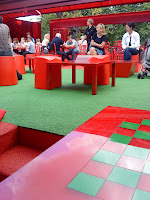Stretches of leafy trees creating depth of field. An aura of calm floats in the air.
Jean Nouvel
Paris, March 2010
This year's Serpentine Pavilion by Jean Nouvel is a gazebo the size of a small jazz bar - and could match Ronnie Scott's for atmosphere, if you go with the continental mood.

Just the sight of this pavilion is a pleasure (so more photos than usual in this posting). If you can find a half-hour to while away some time there, even better - it's around until 17th October. I wouldn't have missed the experience: a huge contrast with my journey to get there, it set me up for the rest of the day.
I wasn't looking for a garden architecture cure when I arrived at Victoria Station around half-twelve on a simmeringly hot day in August. Just searching out a few interesting things to do before visiting a friend in hospital - ideally places I could take some photos or pick up a few postcards to show later. The geometrical design of this year's Serpentine pavilion might appeal; afterwards, I was going on to the Picasso exhibition at the Gagosian.
After riotously crowded train, tube and bus rides, fortunately, as mentioned in my last routine, I got off a stop too early and strolled over towards the gallery via a luxuriant avenue. Then it was on through the park, following aptly serpentine paths lined with ancient trees.

My first sight of Jean Nouvel's pavilion was a primary red wall futuristically radiating sunlight ('DAZZLING . . . A HAZE OF RED . . . like closing your eyes against the sun', in his own words). Past this impressively stark and monumental surface rippling with colour, the structure appeared so open that my initial impression was of scaffolding for a twenty-first century circus tent, probably because of a shapeless piece of canvas hanging inside (a stage curtain of some kind?). A little underwhelming, at first. But, as I discovered, I was missing the point: this wasn't a pavilion just to look at but to spend time in.

Not tempted by what seemed to be a makeshift stand-up cafe/bar and airport cafeteria tables and chairs (I later saw there was more to the interiors too), I headed over to a majestic bank of seating, with matching china red cushions, that reminded me of Gaudi's sinuous tiled mosaic seats in Parc Guell - Brighton also has a fairly recently built row of seating, with inlaid spotlights, in the pedestrianised New Road opposite the Theatre Royal. As you can see, what's different about Nouvel's infinity bench is that the support is diagonally slanted. If you let yourself go here, as most people ultimately did, though some took their time, perching on the edge or sitting bolt upright for a bit, that tilt will potentially transform your mood and personality (more dramatically than a Laz-E-Boy as you're in a public place and there's no inbetween stage).
 If you can allow yourself to lean back, before you know it, you are laidback. All I can say is it was very relaxing.
If you can allow yourself to lean back, before you know it, you are laidback. All I can say is it was very relaxing.The tables in front of the lounge seating had chessboards painted on them, but there were no pieces. Children loved the place, treating the cafe like a playground and the lounge seats like a climbing frame, not in an annoying way, amazingly, just having fun - scurrying up the slope as if climbing up a slide and only just making it to the top before perilously walking along the ridge behind adults who were now almost horizontal and just enjoying the spectacle. On that hot summer's day, the shady pavilion fulfilled the original function of such structures, as originating in Persian pleasure grounds where intersecting paths crossed a pool to meet in the centre at a life-preserving shelter from the heat.

After you've unwound and enjoyed taking it all in, you can wander about a little. Newly appreciative of the space, I walked through the cafe to the table tennis tables just out front and surveyed the scene. Everyone seemed happily absorbed in what they were doing - table tennis players, friends chatting or just sitting and relaxing in the cafe and in what I suppose might once have been called a chill-out area, though lounge suits it better perhaps. I discovered a little corridor behind the bar leading to a mirror-like artwork in alluring shades of red and dusky orange that was a see-through photograph of people sitting in the pavilion's cafe - a double-take.
 You could see people pass behind it and follow them around to an enclosed garden with raised flower beds - strips of summery planting with burgundy and orange canna ('FLEETING SUMMER . . . green against red . . . red berries, vegetables and flowers') with a wide red hammock as a centrepiece.
You could see people pass behind it and follow them around to an enclosed garden with raised flower beds - strips of summery planting with burgundy and orange canna ('FLEETING SUMMER . . . green against red . . . red berries, vegetables and flowers') with a wide red hammock as a centrepiece.  This carefully ordered plot gave a sense of being encircled by gardens and grounds - a feeling of being cocooned, despite the public nature of the space.
This carefully ordered plot gave a sense of being encircled by gardens and grounds - a feeling of being cocooned, despite the public nature of the space.
The hot red pavilion maps on to the cool elegance of the gallery behind it: the structures are thrown into relief and complement each other. The wider landscape is embraced by this temporary building; although it will only be with us for another couple of months, there's something about a transient garden house that's celebratory - of the possibilities of architecture and summer? In Elizabethan times, a spectacular temporary structure was a keynote of festivities.
A pavilion gives you some time out - offers an escape. Garden structures gather people together to relax and enjoy their surroundings and each other's company in a less formal and more private way than usual.
A space like Jean Nouvel's Red Sun Pavilion shows us we're social beings: there's no need to do anything in particular, but it's good to be with other people. Free to stay as long or as fleetingly as you like, in wild contrast with my starting-point, Victoria, which passengers barrel through as quickly as they can, you will probably spend more time there than expected and will emerge recharged.
While you're there, don't miss the Wolfgang Tillman exhibition at the gallery - also free (donations welcome though).
 Lastly, a Sussex connection. The Collector Earl's Garden, designed by Isabel and Julian Bannerman at Arundel Castle (opened 2008) has a charming, miniature banqueting house decorated with wooden antlers and leaves. What makes this garden a true wonder is the elaborate shell grotto based on an Inigo Jones stage set design with its mesmerising jet fountain with a spinning crown.
Lastly, a Sussex connection. The Collector Earl's Garden, designed by Isabel and Julian Bannerman at Arundel Castle (opened 2008) has a charming, miniature banqueting house decorated with wooden antlers and leaves. What makes this garden a true wonder is the elaborate shell grotto based on an Inigo Jones stage set design with its mesmerising jet fountain with a spinning crown. An extraordinarily inventive garden, it's the sort of thing I picture when reading rapturous first-hand accounts of gardens like Kenilworth, Theobalds, Nonsuch and Beddington.
An extraordinarily inventive garden, it's the sort of thing I picture when reading rapturous first-hand accounts of gardens like Kenilworth, Theobalds, Nonsuch and Beddington.
No comments:
Post a Comment